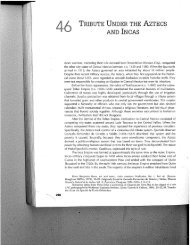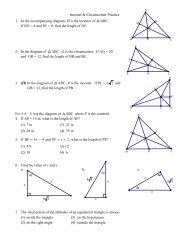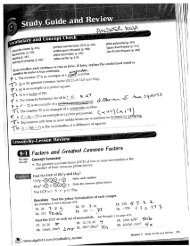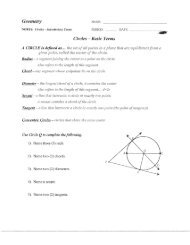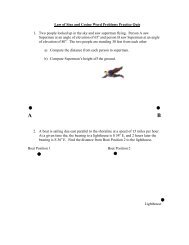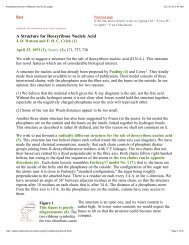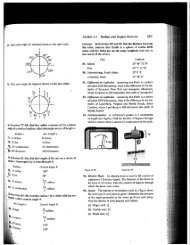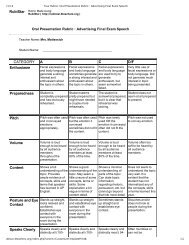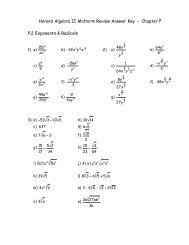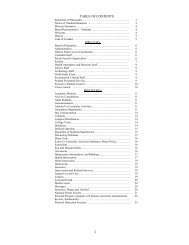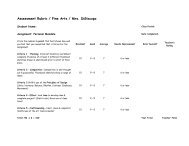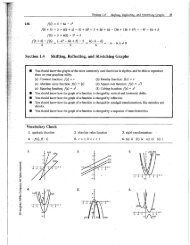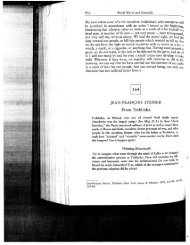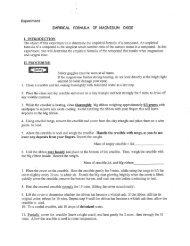Two circuit handouts
Two circuit handouts
Two circuit handouts
You also want an ePaper? Increase the reach of your titles
YUMPU automatically turns print PDFs into web optimized ePapers that Google loves.
Period: I Circuits and Symbols [<br />
Ch. 6:2<br />
Electricity works a lot like<br />
water. Often knagining how<br />
water would work in an<br />
ckcuit wilt tell you how<br />
electricity will work as well.<br />
Electricity flows through <strong>circuit</strong>s: paths of conductors (usually wires),<br />
Any break in the <strong>circuit</strong> will cause the <strong>circuit</strong> to fail, just like a break in<br />
a pipe lets water leak out of a water system.<br />
A closed<br />
<strong>circuit</strong> has<br />
no breaks:<br />
the light<br />
lights up.<br />
An open<br />
<strong>circuit</strong> has a<br />
break in it:<br />
the light<br />
will not<br />
light up.<br />
A break in a <strong>circuit</strong><br />
is any spot where<br />
an insulator is in<br />
the way of the<br />
electricity’ s flow.<br />
Paper, plastic, or<br />
even an air gap<br />
can keep electricity<br />
from flowing~<br />
I<br />
Circuit diagrams are a short-cut method of drawing<br />
<strong>circuit</strong>s. They don’t need to be perfectly draw,<br />
but they can be drawn wrong.<br />
Circuit diagrams<br />
Electrical Symbols<br />
bakery<br />
[ capacitor<br />
These components look similar, but are<br />
very different and have different functions.<br />
wire<br />
battery<br />
-T-<br />
~aths for electricity<br />
to flow.<br />
pushes electricity<br />
through <strong>circuit</strong>.<br />
pipes<br />
pump<br />
light bulb<br />
light bulb<br />
lights up; resists<br />
electricity.<br />
equivalent<br />
switch<br />
switch<br />
turns electricity<br />
on and off<br />
valve<br />
The diagram on the right is a faster way of<br />
drawing the <strong>circuit</strong> on the lefk (Notice the<br />
direction of the battery, which is important)<br />
resistor<br />
resists flow of<br />
electricityl<br />
restriction<br />
in a pipe<br />
Voltage Pushes Electrons<br />
The ends of a battery<br />
are oppositely<br />
charged. This<br />
creates a force,<br />
pushing electrons<br />
thrOagh the <strong>circuit</strong>.<br />
3 Quantities of a Circuit<br />
The flow of electrons we call current<br />
which travels through closed <strong>circuit</strong>s,<br />
Resistance Resists Current Flow [<br />
Devices in the <strong>circuit</strong> do work, which<br />
slows down (restricts) current.<br />
Circuit<br />
continues<br />
Voltage is measured in Volts. Current is measured in Amps. Resistance is measured in Ohms.<br />
www.aisd.net/smurray<br />
These three quantities are lk~ed in any <strong>circuit</strong>.<br />
Change one of them and one or both of the others will change.<br />
Copyright © 2004, C. Stephen Murray
Period:<br />
Types of Circuits and Ohm’s Law<br />
Ch.7:1<br />
Series <strong>circuit</strong>s have all only one<br />
path for the electricity to flow.<br />
<strong>Two</strong> lightbulbs in series,<br />
Each light is dependent<br />
on the other.<br />
If any part of a series<br />
<strong>circuit</strong> is broken, the<br />
<strong>circuit</strong> fails. If either<br />
light is unscrewed both<br />
lights will turn off.<br />
The branches (paths)<br />
of a parallel <strong>circuit</strong> are<br />
independent. If either<br />
light is unscrewed, the<br />
other will remain on.<br />
Your house is wired in parallel, so that each light and<br />
appliance can be turned on and off independently.<br />
Parallel <strong>circuit</strong>s have multiple<br />
paths for the electricity to flow.<br />
<strong>Two</strong> lightbulbs in parallel.<br />
Each light is independent<br />
of each other.<br />
Ohm’s Law I<br />
Voltage<br />
V ~ (in volts)<br />
Current ~ | __~<br />
(in amps)-- ~" --<br />
R ..~._._ Resistance<br />
(in ohms)<br />
Current equals the voltage<br />
divided by the resistance.<br />
Also, V = IR and R = V/I<br />
Abbreviations:<br />
A - Amps - current<br />
v - volts - voltage<br />
~ - ohms - resistance<br />
Increasing voltage<br />
increases current<br />
Increasing resistance<br />
decreases current,<br />
Decreasing voltage<br />
decreases current<br />
Decreasing resistance<br />
increases current.<br />
Ex. How much current does a 12 v<br />
battery push through a 3 ~ resistor<br />
V = 12v<br />
~_=3~<br />
I=<br />
I=V = 12v @<br />
R 3~<br />
Ex. How strong a batteryproduces<br />
2 A through a 3 D resistor<br />
V=v i=~<br />
V So, V= IR<br />
R=3D R = (2A)(3a)<br />
I=2A<br />
Current<br />
Voltage<br />
J<br />
I Resistance I<br />
Current is moving electrons,<br />
moving charge.<br />
Increasing current causes<br />
more electricity to move<br />
through a device.<br />
Increasing electricity through<br />
a device causes it to work<br />
faster (in a motor) or be<br />
brighter (in a lighthulb).<br />
www, aisd net/smurray<br />
Using Otma’s<br />
Law: I = V/R<br />
Using Ohm’s<br />
Law:I = V/R<br />
More current =<br />
brighter light.<br />
Voltage is electrical potential:<br />
how much work a battery can do.<br />
Voltage is linked to energy:<br />
I volt of voltage = 1joule of energy<br />
per coulomb of charge<br />
To increase voltage you could use a<br />
stronger battery OR add batteries.<br />
~<br />
1.Sv~<br />
9volts 1.5 v U 3 volts<br />
total<br />
More voltage is like a<br />
stronger pump, giving more<br />
force and more current.<br />
0 volts total<br />
The lightbulb doesn’t<br />
light here, because<br />
the two batteries are<br />
pushing opposite<br />
directions. To add<br />
together, batteries<br />
must be facing the<br />
same direction.<br />
Resistance slows down current.<br />
Third( of resistance like<br />
a dam holding back water.<br />
Adding devices in a <strong>circuit</strong><br />
increases resistance.<br />
I = V/R<br />
= 6v/3~ = 2 A<br />
The light is bright<br />
because the 6<br />
volts only have<br />
one light to ran.<br />
I = V/R<br />
~<br />
_~_x~ = 6v/6~ = 1 A<br />
Both lights are<br />
dimmer because<br />
the 6 volts have<br />
two lights to run.<br />
More resistance = less current<br />
Less current = less fight<br />
Copyright © 2004, C. Stephen Murray



